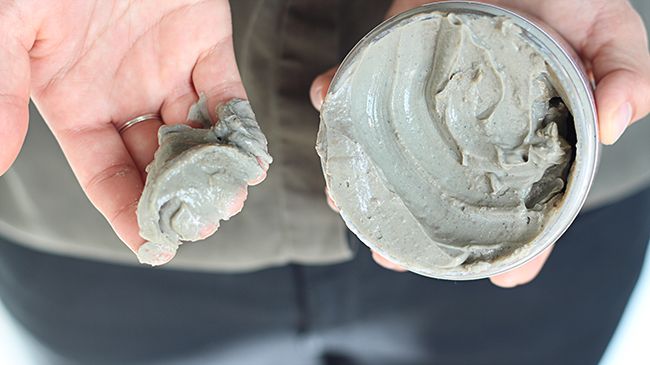When we received a box of clays in the NaturallyCurly offices the Product Junkie inside me got excited – a new product category to explore! But before giving myself my first mud wash I discovered, upon closer inspection of the fine print on the label, that clays should not be used on chemically processed hair. Seeing as I bleached my hair last year and have since been dyeing it, I was glad I hadn’t made that mistake! It made me wonder… why not? And what is the difference between clay and mud anyway? I took my questions to Bridgett Ellington, who has her own line of mud washes from her brand Krave Naturals & Organics.
Why do a clay detox?
Bentonite is a great detox for hair because it acts as a magnet and draws the impurities from the hair to the surface to be washed away. So, if you overdid it with the synthetic products (you know those serums and stylers that claim to repair your dry damaged hair”> detoxing with Bentonite will get you back on track.
Who should use a clay or mud wash?
A mud wash can be used by anyone. The key is the type of clay used to make the mud wash. If you have product build up from synthetics like serums and stylers that make our hair smooth and shiny, you are probably a great candidate for a mud wash. I wouldn’t recommend a mud wash if you chemically process your hair (more on that below”>.
Bentonite is a great detox for hair because it acts as a magnet and draws the impurities from the hair to the surface to be washed away.
Is there a difference between clay and mud?
Yes, to some degree. Clay is a naturally occurring volcanic ash with a high mineral content. It is the main component used in creating a mud wash. When liquids such as aloe vera juice or apple cider vinegar are combined with clay along with other essentials, it creates a fabulous mud wash.
How does Bentonite compare to the other clays out there?
Of the top three:
- Kaolin clay (white clay or China clay”> is the milder of the three. It is a gentle cleansing clay that is great for those who have dry hair in need of strength and elasticity.
- Rhassoul clay (Moroccan Red clay”> has a high mineral content, which makes it a great detox that leaves the hair smooth, soft, and moisturized.
- Bentonite and Rhassoul clay provide similar detox results and their use is based on personal preference. Here at KRAVE Naturals & Organics, we prefer Bentonite!
Why shouldn’t chemically treated or processed hair use clay?
Unless you’re willing to “break up” with your chemical treatments or synthetics you will not be happy with the results. When the structure of your hair is altered with chemical treatments, Bentonite being a negative ion seeks out positive ions (synthetics, plastics, and fillers, etc.”> to remove from your hair. It doesn’t remove the color of your hair. There are no fillers to make the hair soft and shiny. Those who use a mud wash for the first time often state that it caused their hair to feel dry, brittle, and straw-like. Some even vow to never use it again. Many who stayed the course, end up kicking themselves for not trying a mud wash sooner.
Where in the hair routine does a mud wash go? Before shampoo & conditioning? Instead of shampoo?
A mud wash like KRAVE’s Hair Mud can be used in place of a shampoo due to its awesome cleansing properties. One of the great things about using a mud wash is that it’s optional to follow up with a conditioner. When used alone it can leave your hair soft, shiny, and nicely detangled. Whether you follow up with a conditioner is truly a user preference.
How often should you do a clay detox?
Depending on where you are in your “state of hair” and the product build you have to remove; whether you are natural, gradually “weening” yourself off of synthetics and chemical treatments, or going cold turkey, will determine how often a mud wash should be used. Each individual detox may vary.
Is there anything you shouldn’t do when doing a mud wash?
- If you have allergies or sensitive skin, don’t use a new product without doing a strand test first.
- When using KRAVES’ Hair Mud, do not use metal utensils as they can react with the clay rendering it ineffective.
- Do not add water to container.
- For thicker hair, you may want to dispense some of the premixed mud wash into a small bowl with aloe vera juice or apple cider vinegar, just to thin out the mix and ease of rinsing.

